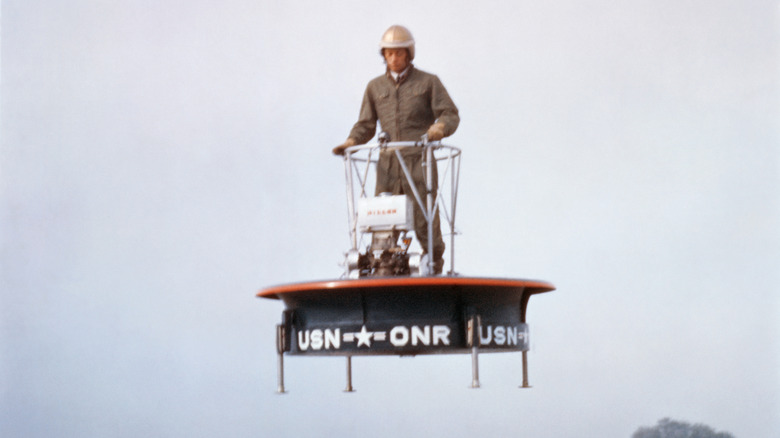The United States military has a lot of incredible toys at its disposal due to decades of procurements, testing, refining, and manufacturing. You don’t get to fly an F-35 or pilot an M1A2 without going through a lot of steps. It takes a lot of time, money, and effort to put a new vehicle or weapon system into the inventory, and what ultimately does succeed is vastly outnumbered by what doesn’t.
For decades, the military has tested and worked on a variety of concepts that never came to fruition. While this could be anything from a canceled self-propelled howitzer like the XM2001 Crusader to a new type of weapon like the Advanced Combat Rifle, there were usually good reasons for keeping those concepts from being fully realized and put into production. One of the strangest and most dangerous examples that falls into this category was the concept vehicle known as the HZ-1 Aerocycle.
New methods of flying troops into an area and inserting them into combat have been developed numerous times over the years, with parachute and air assault equipment usually dominating the battlespace. The Aerocycle was a different approach to achieving this sort of goal. While working prototypes of the Aerocycle proved the technology to be technically possible, it was fortunately not fielded, likely saving soldiers from untimely deaths caused by their own vehicles.
What is the HZ-1 Aerocycle?
The HZ-1 Aerocycle was designed by De Lackner Helicopter Company in the 1960s as a type of flying platform used for reconnaissance missions. The company debuted its new vehicle to the Army, and it worked as promised, leading the Army to order a dozen for additional testing. The Aerocycle consisted of a large, circular platform atop two 15-foot rotor blades that could reach airspeeds of 70 mph and more.
Pilots could steer the Aerocycle simply by leaning in the desired direction, and it worked well enough — at first. Test pilot Captain Selmer Sundby demonstrated the Aerocycle and flew the vehicle on various test flights, including one that lasted for nearly 43 minutes. One thing he determined was the danger in having anyone not familiar with piloting an aircraft being able to use the Aerocycle.
His expertise likely kept him safe, but on the whole, the Aerocycle was not a safe vehicle. The chances of somehow falling through the rotor blades weren’t high, so that wasn’t the overall safety concern. Instead, the real problem arose when the Aerocycle inexplicably lost altitude when the rotor blades flexed and collided, causing the pilot to lose control of the aircraft.
[Featured image by United States Army via Wikimedia Commons | Cropped and scaled | Public Domain]
What happened to the HZ-1 Aerocycle?

Getty Images
Another problem the HZ-1 faced? The high learning curve for teaching the controls to inexperienced pilots, who the Army hoped would be able to operate the Aerocycle. The Army’s hope was to have a soldier receive about 20 minutes of instruction and then be able to fly the HZ-1, utilizing its somewhat intuitive controls to get around. As Sundby’s tests proved, however, people without experience shouldn’t have operated the aircraft, so the HZ-1 wasn’t something the Army could use. And since De Lackner couldn’t overcome any of the Aerocycle’s problems, the Army shelved the idea and moved on to more traditional helicopter designs.
Interestingly, this wasn’t the only attempt the Army made in building a personal helicopter for its personnel.
A contract with a different aerospace company, Hiller Aircraft, resulted in the development of the Hiller VZ-1 Pawnee (pictured above). The design was similar to De Lackner’s but ran into different problems. The Pawnee’s kinesthetic controls were ineffective, requiring the pilot to use traditional helicopter controls to operate it. This eliminated the possibility of having a random soldier pilot the aircraft, so it too was shelved alongside the Aerocycle in lieu of traditional helicopter designs.
[Featured image by United States Army via Wikimedia Commons | Cropped and scaled | Public Domain]